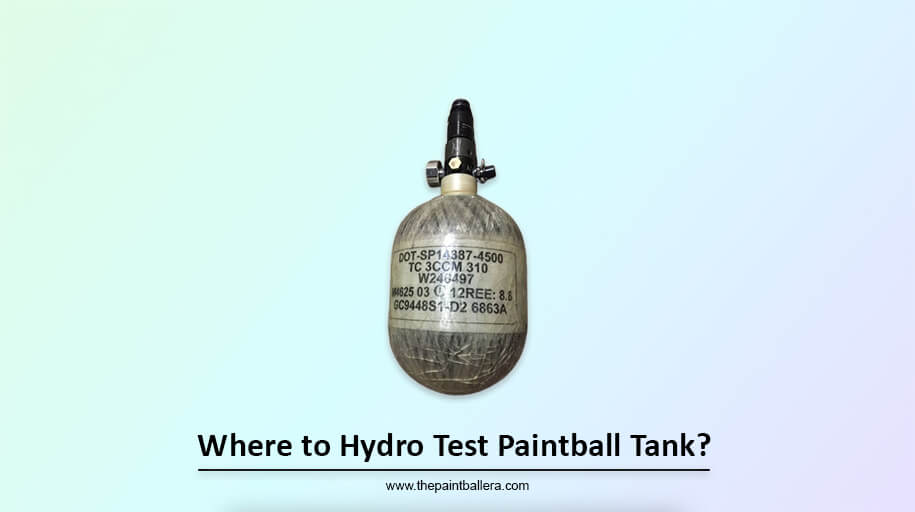Where to Hydro Test Paintball Tank?

Hey paintball enthusiasts, have you ever wondered where to hydro-test your paintball tank? We often overlook it, but it’s vital for safety and performance on the field. A hydro test isn’t just some bureaucratic hoop to jump through—it can be a lifesaver.
Plus, it can help you get the most out of your gear so you’re not caught off guard during a high-stakes match. In this comprehensive guide, we’ll dive deep into the world of paintball hydro-testing, exploring everything from how it works to where you can get it done without breaking the bank.
Trust me, you don’t want to skip this one; it’s essential info for anyone serious about the sport.
PAINTBALL HYDRO-TESTING
So, what’s the big deal about hydro-testing your paintball tank? Well, if you’re like me and love the thrill of a paintball match, you know your gear is your best friend out there. A malfunctioning or compromised tank can ruin your game and put you and others in danger.
Hydro-testing is a procedure used to check your paintball tank’s structural integrity and safety, ensuring that it’s in optimal condition for use.
Think of hydro-testing like a doctor’s check-up but for your paintball tank. Just as you would want to run a marathon with a medical all-clear, you would like to stay on the paintball field with a tank that might be reliable and safe.
It brings immense peace of mind, helping you focus more on your game and less on whether your gear will hold up.
How does it work?
Alright, let’s get into the nitty-gritty. How exactly does hydro-testing work? When your tank undergoes a hydro-test, it’s filled with water and then subjected to a specific amount of pressure.
This is done to simulate the extreme conditions that the tank might experience while in use. After that, the tank is carefully examined for any deformities, cracks, or weaknesses that could indicate it’s not up to snuff.
The reason water is used in the test, instead of air, is because water is incompressible. This means that if the tank were to fail during the trial, the consequences would be far less dramatic (and dangerous) than if it were filled with compressed air.
The goal is to ensure your tank can handle the high pressures it will be subjected to during a paintball game, all while maintaining its structural integrity.
So, if you’ve been delaying that hydro-test for your paintball tank, it’s time to reconsider. Trust me, it’s better to spend a little time and money on this now than face the consequences later.
What Is a Hydro test?
You’re probably thinking, “Okay, I get it. Hydro-testing is important. But what exactly is a hydro test?” Great question! A hydro test is a pressure test where your paintball tank is filled with water and then pressurized to a level higher than it would typically experience during regular use.
This is done to examine the tank for leaks, structural weaknesses, and even the tiniest flaws that could cause a problem later on.
The test is usually conducted in a specialized facility with all the necessary safety protocols. You can’t just DIY this at home, folks. It’s a regulated process that often requires certification to ensure that each tank meets or exceeds safety standards.
A hydro test assures you that your paintball tank is safe to use for another few years. And believe me, that peace of mind is priceless when you’re dodging paintballs left and right on the field.
Why You Should Do a Hydro test?
I know, I know. Life is busy, and adding one more thing to your to-do list might seem like a hassle. But here’s why you should take advantage of hydro-testing your paintball tank. First and foremost, it’s a safety issue.
Paintball tanks are under much stress during a game, holding compressed air or CO2 at high pressures. If the tank has even a minor flaw, it could rupture or leak, causing harm to you or someone else.
Secondly, many paintball fields and facilities will only allow you to play if your tank has been hydro-tested and is up-to-date. You want to be someone other than someone who shows up excited for a game only to be turned away because of an expired or unsafe tank.
Lastly, a successful hydro test ensures that your tank operates efficiently, giving you consistent shot velocity and accuracy. In other words, it helps you perform better in the game, and who doesn’t want that edge?
So, if you’re still on the fence, consider the risks of not getting your tank tested. The investment is worth it for your safety and your paintball performance. Stay with us as we dig deeper into how to know if your tank needs testing, the costs, and even some cheaper alternatives.
How to Know if Your Paintball Tank Needs a Hydro test?
Is it time to get that hydro test done? Generally, paintball tanks come with a specific lifespan and a date stamp that indicates when they were last tested or manufactured. The golden rule is that most compressed air tanks need a hydro test every 3 to 5 years, while CO2 tanks generally require testing every five years.
So, flip that tank around, find that date, and do some quick math. It’s time to schedule a test if you’re near or nearing that timeframe.
Where are the Available Testing Centers?
Alright, let’s say you’re convinced and ready to get your tank tested. You’re probably asking, “Where do I go?” Good news: many places offer this service. Paintball speciality stores often provide hydro testing or can point you in the right direction.
Scuba shops and fire safety equipment providers may also offer this service. And don’t underestimate the power of a quick internet search for “hydro testing services near me” to find your local options.
How Much Does it Cost on Average?
Now, let’s talk money. Hydrotesting your paintball tank, on average, can cost anywhere from $30 to $50. While it might sound like a dent in your wallet, remember that this is a small price for safety and optimal game performance. Plus, it’s a cost you’ll only incur every few years.
How Often Do You Need to Hydrotest a Paintball Tank?
Compressed air tanks usually need a hydro test every 3 to 5 years, while CO2 tanks often require one every five years. Make it a habit to check the date stamp regularly so you’re aware of the situation.
Alternative Places Where You Can Hydrotest Paintball Tanks
If traditional options aren’t convenient or are too pricey, consider looking into welding shops or even some industrial gas providers. These establishments sometimes offer hydro testing services, often at competitive prices.
Which Options are the Cheapest?
Price shopping? Welding shops and industrial gas providers often offer cheaper rates than speciality paintball or scuba shops. But don’t sacrifice quality and safety for cost—always ensure your chosen place has proper certifications.
How Much Does It Cost to Hydrotest a Paintball Tank?
I know we covered the cost earlier, but to reiterate, you’re looking at an average price range of $30 to $50. Some places offer a discount for testing multiple tanks, so if you’ve got a few lying around or your friends need theirs tried too, you could save some money.
Failing a Paintball Tank Hydrotest
The dreaded fail. If your tank doesn’t pass the hydro test, it’s essential to retire it immediately for safety reasons. A failed tank should never be used for paintball games or filled with air or CO2. On the bright side, you’ve just avoided a potentially dangerous situation by finding out your tank is unfit.
Conclusion
So there you have it! Everything you need to know about where to hydro-test your paintball tank. The process might seem tedious, but trust me, it’s a non-negotiable for anyone serious about paintball. Stay safe, play hard, and do all you can to keep your gear in tip-top shape.






